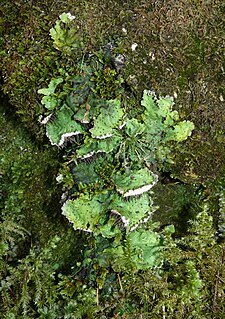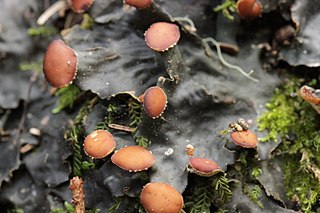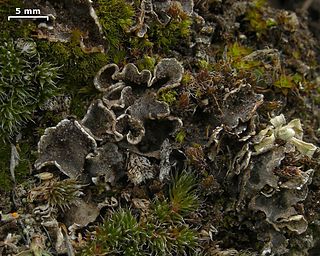
Peltigera is a genus of approximately 100 species of foliose lichens in the family Peltigeraceae. Commonly known as the dog or pelt lichens, species of Peltigera are often terricolous, but can also occur on moss, trees, rocks, and many other substrates in many parts of the world.

Peltigerales is an order of lichen-forming fungi belonging to the class Lecanoromycetes in the division Ascomycota. The taxonomy of the group has seen numerous changes; it was formerly often treated as a suborder of the order Lecanorales. It contains two suborders, eight families and about 45 genera such as Lobaria and Peltigera.

Peltigera leucophlebia is a lichenized fungus in the family Peltigeraceae. It is commonly called ruffled freckled pelt. This and other species in the genus contain a green algae in the genus Coccomyxa and also cyanobacteria in the genus Nostoc as symbionts.

Peltigera membranacea is a species of lichenized fungus in the family Peltigeraceae. It has a foliose growth pattern, with what appear to be veins in the leaf-like parts, but these do not have a vascular function. The apothecia are erect, numerous, and often a bright brown-orange in colour. Some simple sequence repeat markers have been developed for both the fungal partner (mycobiont) of Peltigera membranacea and its Nostoc photobiont partner; these allow for both population genetic studies and an alternative means of identifying between P. membranacea and its lookalikes.
Felt lichen may refer to:

Peltigera aphthosa is a species of lichen known by the common names green dog lichen, leafy lichen, felt lichen, and common freckle pelt. It has a circumpolar distribution, occurring throughout the Arctic, boreal, and temperate regions of the Northern Hemisphere.
Peltigera vainioi is a species of lichen in the family Peltigeraceae. It is found in high-elevation locations in South America. It is a somewhat unusual species in its genus, characterized by a single holdfast that attaches to its substrate, and pores in its cortex.

Peltigera canina, commonly known as the dog lichen, is a widely distributed species of foliose lichen in the family Peltigeraceae. It was originally described by Carl Linnaeus in his 1753 work Species Plantarum. German botanist Carl Ludwig Willdenow transferred it to the genus Peltigera in 1787. This species is currently undergoing research as it is likely multiple species under one united name.

Peltigera horizontalis is a species of lichen in the family Peltigeraceae. It was first described by British botanist William Hudson in 1762 as Lichen horizontalis. German botanist Johann Christian Gottlob Baumgarten transferred it to the genus Peltigera in 1790.

Peltigera lepidophora, commonly known as the scaly pelt, is a species of foliose lichen in the family Peltigeraceae. It was first described by Finnish lichenologist Edvard August Vainio in 1878 as a variety of Peltigera canina. German botanist Friedrich August Georg Bitter promoted it to species status in 1904.

Peltigera lepidophora, commonly known as the fan lichen, is a species of foliose lichen in the family Peltigeraceae. It was first described by Carl Linnaeus in his 1753 work Species Plantarum as Lichen venosus. German botanist Georg Franz Hoffmann transferred it to the genus Peltigera in 1789. P. venosa can be found in temperate and boreal regions of North America, Europe, and Asia, while occasionally being found in drier climates such as mountainous Arizona.

Peltigera degenii is a species of foliose lichen in the family Peltigeraceae. It was first formally described in 1927 by Hungarian lichenologist Vilmos Kőfaragó-Gyelnik. The Chinese species Peltigera neodegenii is similar in appearance. Peltigera degenii has a shiny upper surface. In North America, it is a relatively rare forest species.
Orvo Vitikainen is a Finnish lichenologist. He entered the University of Helsinki in 1961, from where he obtained a Candidate of Philosophy degree in 1966, and a Licentiate of Philosophy in 1971. He later earned a Ph.D. from this institution in 1994, under the supervision of Teuvo Ahti. Between the years 1961 and 1981 he was a junior curator of cryptogams at the University of Helsinki Botanical Garden, and then from 1983 to 2004 he was the head of the lichen herbarium. Here he managed the internationally valuable collections of the early lichenologists Erik Acharius and William Nylander. He has collected thousands of specimens for the herbarium from various locations in Finland, but also internationally, including Sweden, Norway, Denmark, Russian Karelia, Scotland, Austria, Italy, Hungary, Croatia, Montenegro, Tanzania, Kenya, British Columbia, and Brazil. In 1992–1994, he was a scientist of the Finnish Academy in the Ahti research group.

Peltigera praetextata, or the scaly dog pelt lichen, is a foliose lichen native to North America, Europe, and Asia. It is defined by small belly-button-like growths called phyllidia on its edges and centre.

Peltigera gowardii, or western waterfan, is an aquatic lichen found only in mountain streams of Western North America. It is the largest aquatic lichen in the Pacific Northwest.
Peltigera islandica is a cyanolichen indigenous to Iceland. Only recently discovered in 2016, it is likely that specimens currently labelled as P. membranaceae or P. neorufescens could in fact be P. islandica. This species is currently known in only Iceland and Canada.
Peltigera papuana is a lichenized fungus in the family Peltigeraceae. It was described in 2009 from Madang Province of Papua New Guinea, from which it obtained its specific epithet. Genetic analysis of both the mycobiont and the photobiont, which is a Nostoc cyanobacterium, suggests that the evolutionary origin of Pelitgera papuana is from an ancient dispersal event from South America, although this remains inconclusive.

Peltigera rufescens, commonly known as the field dog lichen, is a species of terricolous (ground-dwelling), foliose lichen in the family Peltigeraceae. The common and widespread species has a cosmopolitan distribution.
Peltigera shennongjiana is a species of terricolous (ground-dwelling), foliose lichen in the family Peltigeraceae. Found in Central China, it was formally described as a new species in 2016 by Liu-Fu Han and Shou-Yu Guo. The type specimen was collected from Laojunshan Mountain in the Shennongjia Forestry District at an altitude of 900 m (3,000 ft); here it was found growing on mosses over rocks and soil. The species epithet refers to the type locality.
Peltigera wulingensis is a species of terricolous (ground-dwelling), foliose lichen in the family Peltigeraceae. It is found in northern China.












